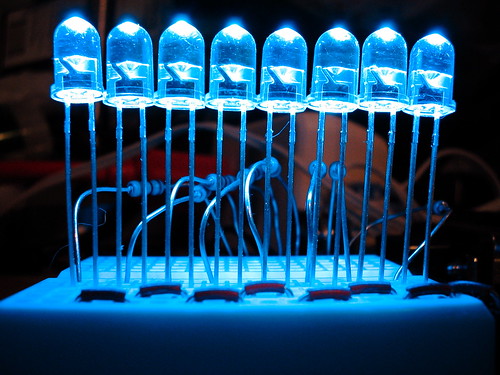|
There are some scopes out there from sellers who only sell electronics equipment, and they often have a 7 day guarantee on their scopes. Obviously, also look for high ratings and a large (98+%) positive feedback proportion. I am trying to find this one dude who had a ton of scopes, and all of them were fully tested and guaranteed.
|
|
|
|

|
| # ? Apr 26, 2024 21:40 |
|
I thought of a good project, though it's legality is dubious. Every FM transmitter (for ipods, etc.) on the market sucks. My theory as to why, is that FCC laws limit the transmit power to something so low a sneeze will cause static. How about we crack open one of these guys and see about boosting the signal power? I think I may have a few at home I bought off Woot. I think this can easily be done by simply adding a tuned antenna, or via the more involved route of actually building an amplifier. Hillridge fucked around with this message at 14:45 on Jan 24, 2008 |
|
|
|
Hillridge posted:I thought of a good project, though it's legality is dubious. I've often pondered this as well, and would be interested to hear some more experienced people's takes on this, since I know next to nothing about radio transmission.
|
|
|
|
Hillridge posted:I thought of a good project, though it's legality is dubious. No problem. Build this: http://www.electronics-diy.com/BA1404_Stereo_FM_Transmitter.php This is a very nice FM transmitter because it's actually stereo. Most schematics you find on the net are not. And add any RF amplifier you'd like after it (provided it has a good frequency response on the FM frequency range). This looks pretty cool: http://www.irational.org/sic/radio/40w-no-tune-amp.html
|
|
|
|
I'm about to make Futurlec richer and need some advice. I'm just wanting to stock the junkbox. I've previously purchased about $40 of assortments and kits from VAKits; the prices are OK but I need more components and their selection is meh. I want to get a breadboard development setup and start messing around with analog circuits at first, moving up to TTL and CMOS in a bit. I also want to perhaps play around with RF stuff at the HF/VHF/UHF level (preamps, converters, simple stuff like that), built dead-bug style on the stack of copper clad boards I have here at my desk. Anybody want to help me come up with a basic shopping list to stock the cupboards? I have good starting stock on resistors, ceramic and electrolytic caps, 1n914's and 1 amp power diodes. 1x basic DMM - $5 -1x 390 point breadboard - $6 -1x 840 point breadboard - $3 -1x jumper kit - $5 - 300 piece 1/4 watt resistor assortment - $2.50 - 100 Linear IC assortment - $6 - I have maybe 2 dozen op amp/regulators right now, want more - 100 Transistor assortment - $5 Now I'm wanting some suggestions for some components I should grab by the dozen. Thinking 2n3904/3906, LM2902's and LM2904's for opamps, voltage regulators in 5v/9v/12v, a couple cheap TO-3 or TO-220 power transistors, maybe some FETs (mpf102 for radio circuits?)... Any thoughts for good 'starter parts'? I like cheap, flexible parts; money's tight these days. Edit: My first project will be to grab a power transformer from Radio Shack and build a 5v/12v/variable voltage power supply - 1 amp on each should be plenty room. Jonny 290 fucked around with this message at 23:18 on Jan 24, 2008 |
|
|
|
Jonny 290 posted:I'm about to make Futurlec richer and need some advice. For OpAmps, I like TL072s or TL082s. Very low noise for the price. The 72 is a JFET opamp and the 82 is a BiFET opamp. 2N3904/2N3906 are fine for the transistors. If you don't want to get both, stick with the 2N3904s. You'll see them more often, and anywhere you see a PNP transistor in a circuit you can just flip the polarity of the rest of the circuit and use the 3904 instead. Or you could just pick up both... they're cheap enough. Don't forget some diodes. Get an even assortment of 1N400x diodes as well as 1N914 silicon diodes. The only major difference in the 1N400x diodes is the max current. 1N4001s are good up to 1 Amp, and the rest are all higher. (Edit: meant to mention that the reason for picking up the 914s is because they tend to be a little "smoother" when clipping as compared to the 1N400x series. Not that you intend to push them to that point, but when dealing with varying input signals and opamps there's always a chance you'll clip unexpectedly. If you don't really care about clipping characteristics, don't bother getting the 914s) Check out Small Bear Electronics for some nice pre-sorted capacitor sets in film and electrolytic varieties. http://www.smallbearelec.com OOPS Completely missed the part where you said you already had diodes and caps. Oh well. Sorry scholzie fucked around with this message at 23:41 on Jan 24, 2008 |
|
|
|
Here are some bits ive got to Build an amp.  Just things I had kicking about in my shed. MJ15003 NPN Power Transistor 14 MJ15004 PNP Power Transistor 19 MJ2501 PNP Power Transistor 5 MJ3001 NPN Power Transistor 7 Transformer 30v+30v 530VA 2 Transformer 9v+9v 100VA 2 Now i know i wont need all of the bits. and will need some others. Can anyone Create a diagram . or Link a diagram for using the 5003/5004 Transistors in an amp?? i can build the PSU part fine. just not great at amps. would like 300-600 rms for a SUB 8ohm and option for sterio output.
|
|
|
|
The Radiskull posted:Here are some bits ive got to Build an amp. That transformer (the 530 VA one, the only one you should consider for this project) will suitably drive an amp up to about 250, maybe 275 watts maximum without exceeeding its ratings. From what I remember, linear power supplies are about 50-70% efficient depending on the design. Here is a design for an amp based on those transistors. This would be a good design for you to start out with.
|
|
|
Jonny 290 posted:From what I remember, linear power supplies are about 50-70% efficient depending on the design. Efficiency of linear regulators is Vout/Vin (if you assume quiescent current is zero, that is. It's usually so small it's negligible).
|
|
|
|
|
Hillridge posted:I thought of a good project, though it's legality is dubious. I've seen plenty of FM transmitters up on sites for educational purposes and HAM operators. You could very easily take one and make your own transmitter, or an amp for a transmitter you have already. Some of those systems are pretty ridiculous though, and meant for high-power broadcasting rather than getting Sirius to play in your car. I have no doubts that running a roving 40W pirateFM station from a Jeep would be both highly illegal and extremely hillarious. Imagine the look on people's faces when the christian rock they had on earlier is slowly replaced by Slayer, which gets progressively louder and more in tune until a speeding Jeep blows by, then slowly fades off. (Awesome mental image) There are some modifications for things like the Zune transmitter and the iTrip available. All of them are basically 'add some wire where the antenna should go, enjoy better reception'. http://www.zunemods.net/cms_view_article.php?aid=13 http://www.surfbits.com/?p=526 I believe a 1/16th wavelength antenna might actually work pretty well for this kind of thing (at the risk of HAM operators coming to flog my rear end for saying that...pretty sure I'm right though). The calculation for this is: Speed of light / Target Frequency / 16 = Antenna length Length for an 88.7MHz antenna: 0.698 feet Round it off to 11/16 of a foot. That's 8-1/4". Some bare wire is better than nothing, although ideally the straighter the antenna the better. Also having it in orientation with the car's antenna helps too (so facing towards the sky or towards the ground). Run a length of bare wire 8-1/4" off of where the antenna normally connects to on the transmitter. You'll have to solder it on. I'd add some glue to the side of the transmitter box to make sure you don't jerk the wire out and ruin the PCB. Even a bit of extra wire helps. The closer to an antenna wavelength you can get it the better, although at very small lengths it won't matter so much. It probably doesn't matter as much even at that length, to be honest. Bonus point for anyone who puts a 1/4-length antennna on their car and drives around with that 40 watt transmitter. Bonus, bonus points if you catch the attention of the FCC! Jonny 290 posted:Stuff I agree with scholzie's suggestions. Also going to add that the HEF4007 is a great source for small, cheap MOSFETS. They're designed for digital stuff, but they work pretty well for RF circuits (not so hot for higher than say, 80MHz-ish). They are certainly not power FETs though. I'm also about to go grab some JFETs too, I keep seeing them in DIY schematics all over the place. Might be worth picking a few. Also, for a variable linear power supply, can't go wrong with the LM338 IC. 5 amps of fury (provided everything else will take 5 amps and you're drawing 5 amps) and a dead-simple build. Two capacitors, two resistors are all you need (although I'd add a large capacitor on the input, couple of thousand microfarads). clredwolf fucked around with this message at 03:34 on Jan 26, 2008 |
|
|
|
clredwolf posted:Bonus point for anyone who puts a 1/4-length antennna on their car and drives around with that 40 watt transmitter. Bonus, bonus points if you catch the attention of the FCC! Not that I would try this, but can they easily figure out that you are the one transmitting?
|
|
|
|
Yeah, they have RF field strength meters and they're trained to know when X transmitter is close enough to see. Direction finding gear is pretty snazzy - I used to foxhunt back when I was a kid. Learning news: OH GOD I FIGURED OUT HOW JFETS WORK. I built a little lovely preamp in Multisim and it's dutifully amplifying my little 10 mV signal to 50mV with much better output impedance. Am I to understand that I shouldn't be looking at JFETS for low impedance (<10K ohm) circuits? They seem very sensitive to high-impedance signals but not really able to give low impedance outputs, no matter how I set the biasing resistors. I also got a nice unity gain JFET amp for 10 MHz going, as I need it to use as a buffer between an IF stage on one of my scanners to my ham rig's RX antenna input, without loading the scanner stage. Using an MPF102, going to mock it up this weekend.
|
|
|
|
Skycks posted:Not that I would try this, but can they easily figure out that you are the one transmitting? A guy I might know (i.e., if this were to have come up, I didn't know him) used to have a massively illegal CB amp. He claims he was heard in Nova Scotia once (I certainly wasn't standing beside him at the time), with the reply (something along the lines of "what the hell was that?") passed back down to Texas via the chain of closer-to-legal transmitters. (Before you go calling the FCC, he sold it several years ago to buy a Harley.) That reminds me, what's the average Chillbro Baggins fucked around with this message at 05:51 on Jan 26, 2008 |
|
|
|
It depends on the CB set, more specifically, how overbuilt it was at the factory. Some use output transistors that poo poo the bed at 12 watts; others will easily 'swing' 30. I'd say that most truckers are running between 25 and 100 watts with their peaked-and-tuned radios. Sky's the limit if they're hooking up amps. Now this means in no way shape or form that you are putting out more _clean_ power. If the radio is designed in a lovely manner, as soon as you set it for more gain, harmonics show up. Any time you are operating near the performance envelope of an active device like a transistor or tube, you're going to get distortion and harmonics. This is why people hate CB'ers who run too much juice - it's not how loud you are on 19 that bugs the FCC, it's the poo poo you spew out from channels 1-40 and higher that annoys people.
|
|
|
|
Jonny 290 posted:That transformer (the 530 VA one, the only one you should consider for this project) will suitably drive an amp up to about 250, maybe 275 watts maximum without exceeeding its ratings. From what I remember, linear power supplies are about 50-70% efficient depending on the design. That Looks Perfect. will give 400W rms into 8ohms. That site is very helpfull too. Thanks
|
|
|
I was reading this site: http://users.pandora.be/worldstandards/electricity.htm and it has the following information on it:quote:Europe and most other countries in the world use a voltage which is twice that of the US. It is between 220 and 240 volts, whereas in Japan and in most of the Americas the voltage is between 100 and 127 volts. If you look at the map they include, a large portion (and notably, China and India) are at 50 Hz. Do they actually mean 20% less than 60 Hz? It seems like 20% of Europe and Asia is a shitload of energy, and a gigantic waste of that energy to boot. I can believe it's less efficient, but I have a hard time buying these numbers - they just don't pass my bs filter. What do you guys think?
|
|
|
|
|
Delta-Wye posted:I was reading this site: http://users.pandora.be/worldstandards/electricity.htm and it has the following information on it: Small novel ahead: Westinghouse (the company that backed Tesla) went with 60Hz before everyone else, and AEG went with 50Hz. It had to be a frequency higher than 40Hz (or else the lights would flicker and look annoying) while being below 100-ish Hz so motors could work. The article is wrong about the transmission lines though. You actually lose more power at higher frequencies, especially on high voltage transmission lines. The ideal condition there is, ironically enough, DC power. Modern power electronics have made HVDC transmission lines possible and they are more efficient than AC at high voltages. 50Hz does require larger transformers, since the higher the frequency the more efficient the transformer (RF transformers are extremely efficient compared to their 50/60-Hz cousins, but are used for a different purpose). In actual transmission across lines though, 50Hz is more likely to have less power losses across the lines. The article would be mostly correct, except that nowadays technology is at a point to where it's not that big of a deal anymore. Your computer power supply, for instance, is so efficient because it takes the incoming 50/60Hz line and turns it into a very high frequency (typically in the MHz range), where that is converted to different voltages through some tricky circuitry that exploits the high frequency's efficiency in voltage conversion. HVDC lines do the same thing but instead of high frequencies, they convert to DC (or 0Hz) for super-efficient transmission. Transmission lines can also be designed to minimize power losses at whatever frequency travels across it, and transformers can be designed with tricks to make conversion easier. Basically, it's not a big deal anymore. The 120V/240V thing is mostly for safety. 240V is actually much more efficient, as you need thinner wire and less current inside houses and buildings to carry the power, which is cheaper and in most cases would have less power loss across the wire. However, 120V is safer when shorted out or when a person accidentally shorts themselves across the wire. The same thing is happening in cars nowadays. 12V is pretty safe, and in most cases shorting 12V DC through your body only causes a mild shock. Car companies are wanting to move to 48V though (or something higher than 12V) because all of the electronics in modern cars require some very heavy gauge wire to be powered, which is expensive. A higher voltage means a lower wire gauge, and less current to boot (so cheaper fuses, more efficient starting, etc). However, 48V can actually kill you. So if you wreck in the rain it's now possible for you to die from electrocution off a live wire. edit: I should mention that despite the current state-of-the-art in power electronics, the power grid is a mish-mash of new and old (mostly old because it's expensive to upgrade). So practically, the article is right that there is a difference. clredwolf fucked around with this message at 07:37 on Jan 27, 2008 |
|
|
|
Jonny 290 posted:I'm about to make Futurlec richer and need some advice. I know people say it about the waiting times on futurelec, but honestly, i've had an order in since November 28th and i'm still waiting on a common item (piezo buzzers?). I emailed them and got an answer the first two times, but they haven't bothered responding to any more. I needed the parts for school but i ended up just ordering from Jameco and they got here in two days, everything was alright except no ceramic caps, an extra bag of switches (mostly dip switches), the "pot assortment" is all trimmer pots, and resistor assortments that were either 470k or 6.8ohm. Anyone know a company that doesn't gently caress up constantly?
|
|
|
|
sithael posted:Anyone know a company that doesn't gently caress up constantly? I've NEVER had a problem with Jameco. I love them. I also like Small Bear Electric, but they are mostly parts geared towards guitar effects and related items. However, they're also a great place to pick up assortments. They're a little pricier than most places you find, but I've never missed with them and they've always had everything I've ever needed. YMMV, obviously.
|
|
|
|
mtwieg recommended I post here. I build lasers, and I need help making a circuit for a laser diode. I've built circuits that drop voltage down, but now I want one that steps voltages up. This is for the better battery options... like a single AAA 1.5V source, etc. Now, I have no idea how to go about making a reliable circuit that does this. I need it to put out 4.5-5.5V (5V preferably) and 35-45mA current to this diode. If it's possible to vary these precisely with a resistor swap (or pot), let me know. Is there a way to adjust current/voltage output on these? If I'm missing any pivotal information, let me know as well.
|
|
|
Jayls5 posted:mtwieg recommended I post here. Generally the voltage is set the same way as an lm317: a resistor divider from output to ground, with the divided voltage being held at some reference voltage.
|
|
|
|
|
mtwieg posted:What you want is called a Boost converter (sometimes called a step up regulator), which can take voltages a low as 0.5 volts and turn it into something higher. They're pretty efficient (usually over 80%, sometimes as high as 95%), but they're slightly tricky to use. Also, you won't find them in your local radio shack, so you'll most likely have to order them online. Right, I've researched it before. I've read the article you posted and a few others. I still haven't been able to find a specific circuit design of the type I need. That's my main issue. Lots of LED flashlights use these step up regulators, but they put out way too much current for my application. That's my dilemma 
|
|
|
Your circuit would look something like this: Your output could be adjusted via any of the three resistors. The exact design and component values will depend on your boost converter (datasheets typically tell you exactly what you need to know). When you say they give to much current out, I think you're misunderstanding what these things do. They regulate voltage, not current (though most will limit the current output). You control current by voltage and the load impedance at that voltage. ANIME AKBAR fucked around with this message at 04:18 on Jan 28, 2008 |
|
|
|
|
You can also do this quite easily with a charge pump and you might actually find the one special part you need from radio shack. Edit: I'm looking for some easy to read information on charge pumps. Here's a fairly simple schematic which uses a 555 timer, some caps and schottky diodes. You can find everything there at radio shack. It's a voltage quadrupler. http://home.pacbell.net/lengal/ip/cpump.pdf Given the pumping nature of this circuit the output tends to be a little rippley, since the caps are discharging and recharging. Putting a relatively large output cap (compared to the others) will smooth that out to near-DC. scholzie fucked around with this message at 19:23 on Jan 28, 2008 |
|
|
|
charge pumps are nice for their simplicity and and efficiency, but they have their limitation. They're limited to low-current loads, since they require low-esr capacitors to work properly, and therefore you really can't just stick a giant electrolytic on the output to reduce ripple. Also, they are unregulated, so you're usually stuck with inverters or doublers. I use them when I want to make a tracking negative power rail for battery powered devices, but beyond that I'll usually go for a boost/buck converter.
|
|
|
|
|
mtwieg posted:Your circuit would look something like this: Well, like I said, I'm not that great at this stuff yet. I have a few questions... Will something (such as a laser diode) only pull a specific current at a certain voltage? Is that why a steady voltage source implicitly acts as a current regulator? I was trying to tell my friend this originally if that's the case. Now, I am concerned about the properties of a diode itself. It is my understanding that they get "runaway" resistance. As temperature increases, resistance decreases on the diode... further increasing the current and heat to it as a result. This quickly results in diode death. Now, on these boost converters, the circuit will keep this from happening? Part of the picture in your link is cut off on both sides, do you have the rest of it? I really appreciate the help.
|
|
|
|
mtwieg posted:charge pumps are nice for their simplicity and and efficiency, but they have their limitation. They're limited to low-current loads, since they require low-esr capacitors to work properly, and therefore you really can't just stick a giant electrolytic on the output to reduce ripple. Also, they are unregulated, so you're usually stuck with inverters or doublers. I use them when I want to make a tracking negative power rail for battery powered devices, but beyond that I'll usually go for a boost/buck converter. 35-45mA IS a low current load. And it's not true that you're stuck with inverters or doublers. And you don't need a "giant" electrolytic cap on the output, just enough to smooth the ripple past the point where it's hampering your needs. I doubt it would be much of an issue at all if the load was the laser diode circuit. He could at least try it and see if it worked first. scholzie fucked around with this message at 20:12 on Jan 28, 2008 |
|
|
|
Ah I miss dabbling in raw electronics. One of my favorite things from my years back in HS electronics class was wire wrap. I just adore wire wrap vs. breadboarding. Not sure whey exactly. I'm anxious to get back into it all, but either don't have a project in mind or don't want to waste money on components if i'm not sure it will work. I guess I should find some decent simulation software, but its often hard to find one that either works or has the right components.
|
|
|
|
sithael posted:I know people say it about the waiting times on futurelec, but honestly, i've had an order in since November 28th and i'm still waiting on a common item (piezo buzzers?). I emailed them and got an answer the first two times, but they haven't bothered responding to any more. I needed the parts for school but i ended up just ordering from Jameco and they got here in two days, everything was alright except no ceramic caps, an extra bag of switches (mostly dip switches), the "pot assortment" is all trimmer pots, and resistor assortments that were either 470k or 6.8ohm. I'll admit I don't feel good about my Futurlec order until it comes in. They say they processsed it today, so that's a 3 or 4 day time so far. I like their store a lot because they have selection, but it's not a Mouser-type gigantic selection where I'm staring at 78 varieties of an LM386 trying to figure out which one I want. I'm not quite to that point, and I like assortments and 'packs' much more than buying 10 of each component I think I might need - after all, my experimentation is open ended and I don't know exactly what I want to build when I order the parts, just have general ideas.
|
|
|
Jayls5 posted:Will something (such as a laser diode) only pull a specific current at a certain voltage? Is that why a steady voltage source implicitly acts as a current regulator? I was trying to tell my friend this originally if that's the case.  Usually you will operate it at around the "turn on" voltage, where it starts looking like a low impedance. Just putting a resistor in series with it of appropriate size will usually work fine (as in the schematic I posted). As for current regulation, it most likely isn't necessary. I highly doubt the properties of the diode will change enough to significantly change its power output. Do you have a datasheet for the diode?
|
|
|
|
|
mtwieg posted:Diodes aren't characterized by resistance. They have I vs V characteristics which generally look like this: I think this is the same one I have: http://www.photonics.uk.com/products/sanyo_violet_laser_diodes/dl-3146-151.pdf
|
|
|
Jayls5 posted:I think this is the same one I have: Everything seems fine, then (though parts of the pdf won't display). The circuit I showed should be fine. The best way to regulate current would be with the series resistor. I doubt the diode's heat will have enough positive feedback to cause it to fail. If you really want to, you could use a circuit that makes a current source out of your voltage source. A simple one would be as follows:  A normal red LED provides a stable voltage reference of around 1.5 volts (this may vary from LED to LED, but the point is it remains pretty much constant regardless of the load on the circuit). The current through the laser diode will be (practically) equal to the current through R2. The voltage across R2 will be the Voltage of the red LED minus the base emitter voltage of the transistor (0.6 volts). To sum it up, the laser LED current is equal to (Vd - Vbe)/R2, or 0.8/R2. So you can easily adjust R2 to change current (just make sure it can't go to zero). You will still need to boost the voltage, since at the very minimum the LED needs 3 or four volts. Supplying this with five volts from a boost converter should be fine. The one downside of this is that it requires some extra current in order to get that 1.5V across the red LED. There are more efficient ways to do it, but they're fairly complex and aren't worth the trouble. Also, did you ever simple consider using a higher voltage batter?
|
|
|
|
|
mtwieg posted:<current sources> You just got me to understand current sources. Awesome. To test, I mocked up a cheap 2n3904 amplifier and for bias, I built a 2n3906 positive current source using a pair of 1N914's and a resistor to drop 1.2v at 1 mA. Pulled the base bias off that Vcc-1.2V junction and used a resistor to bias the transistor for 1 mA current. Perfect!
|
|
|
|
I notice Radio Shack sells these. Is this a good kit to use to get into the hobby? My father was an EE. He gave me a bunch of his equipment. I have no idea if it's useful or way obsolete. Any idea on these things? Probably from the 1960s or earlier: HP 130c Oscilloscope GR 1311A Audio Oscillator, General Radio EDIT: found one for sale on ebay Wisdom fucked around with this message at 22:44 on Feb 1, 2008 |
|
|
Wisdom posted:I notice Radio Shack sells these. Is this a good kit to use to get into the hobby? Try the microcontroller thread for this kind of stuff.
|
|
|
|
Wisdom posted:I notice Radio Shack sells these. Is this a good kit to use to get into the hobby? I've got one, it's fun to play with but I really recommend starting out with something like the Atmel AVR Butterfly. Smiley Micros sells a great kit with everything you'll need for $99 (same price as the BASIC Stamp kit) including a C Programming for Microcontrollers book. I bought the plain Butterfly from them in 2005; they didn't offer the "everything" kit then. Edit: Yay Macro Photography 
mrbill fucked around with this message at 13:05 on Feb 2, 2008 |
|
|
|
|
Wisdom posted:I notice Radio Shack sells these. Is this a good kit to use to get into the hobby? Mrbill is right on this, BASIC stamps are fun but kinda limited. AVR's and PIC's are better microcontrollers, and are easy enough to get into especially if you have any programming experience. Wisdom posted:HP 130c Oscilloscope That oscillator looks like you could use it as a signal generator, which is pretty useful (albiet yours is pretty low frequency, but whatever works). The Oscilloscope definitely looks older (500kHz max range), but a scope is a scope and unless you want to do RF work I think you'd be okay.
|
|
|
|
I have noticed recently that my parts kit is really lacking in variety of components. I have sorted resistors and any parts I need for my classes but I would like to expand a lot. I really like the idea of buying the presorted resistor boxes and stuff because it is so much easier than going through them later. Anyway can anyone recommend a site that sells presorted components in pretty large numbers. Small Bear Electronics had a nice selection of caps but I am looking more into some 1% resistors, electrolytic caps, and well I don't even know anymore. Also a site that sells good soldering irons besides e-bay would be nice. I have a relatively decent weller adjustable iron but I am looking to move to a real soldering station with more precise temperature control. EDIT: I am an idiot and should have checked jameco. I have used them before but never realized they had the grab bag things which are awesome. Locker Room Zubaz fucked around with this message at 22:55 on Feb 2, 2008 |
|
|
|
Cuw posted:Also a site that sells good soldering irons besides e-bay would be nice. I have a relatively decent weller adjustable iron but I am looking to move to a real soldering station with more precise temperature control. HMC electronics has Metcal stations reasonably priced. Although I bought my SP200 off ebay and it has worked flawlessly.
|
|
|
|

|
| # ? Apr 26, 2024 21:40 |
|
Cuw posted:EDIT: I am an idiot and should have checked jameco. I have used them before but never realized they had the grab bag things which are awesome. Jameco grab bags are amazingly good deals. My only beef is that they tend to leave out some useful stuff from them. For example, my resistor bag has not a single resistor above 800k (although I have some 1Mohm resistors around). Their 7400-series bag also has some pretty worthless chips in it, although they gave me an insane amount of 8-bit registers (so I can't complain too much). Seriously though, I wanted to open that bag and find a 74181 in there. Or twelve. Also, if you're still looking for a solder station, Digikey sells some nice ones. edit: Seriously, I just counted 9 646s. What the heck am I going to do with that many? clredwolf fucked around with this message at 00:54 on Feb 5, 2008 |
|
|












 Bad Angus! Bad!
Bad Angus! Bad!





